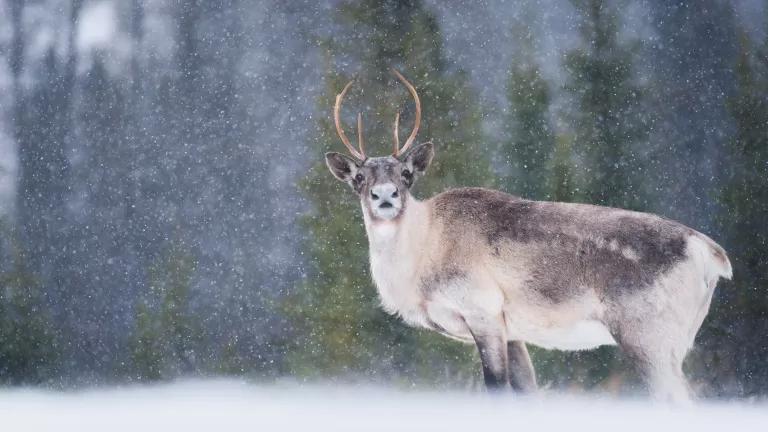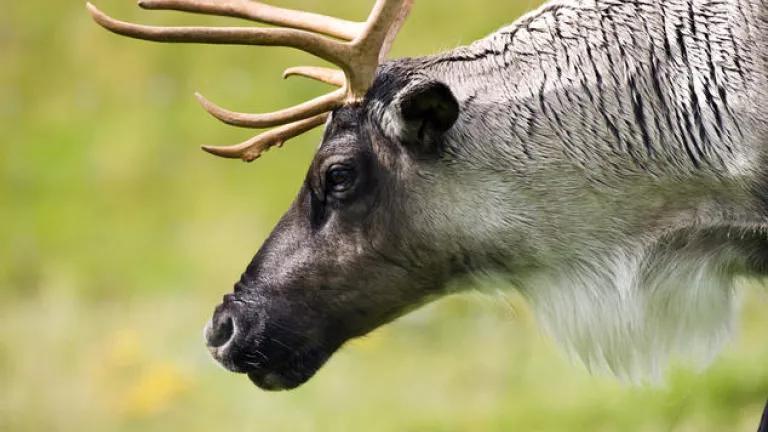Quebec Degrading Caribou Habitat: Federal Government to Intervene
As some caribou herds in Quebec approach the “threshold of near disappearance", the federal Minister of Environment calls for emergency measures...again.

A caribou standing at the edge of a forest in Charlevoix, Quebec
Jérémie LeBlond-Fontaine/Getty Images
On the brink of local extinction, three of Quebec’s most at-risk boreal caribou populations could soon receive emergency protection from Canada’s federal government. In June, Steven Guilbeault, the Minister of Environment and Climate Change Canada, recommended federal intervention to protect Quebec’s Val-d’Or, Charlevoix, and Pipmuacan caribou herds, which have experienced precipitous declines in recent decades due to industrial activities, including logging.
While provinces and territories are largely responsible for the management of land and wildlife within their boundaries, Canada’s Species at Risk Act (SARA)—a federal law designed to protect species and their habitat—includes a provision that allows the federal government to intervene when provinces fail to implement adequate protections for endangered wildlife. Section 80 of SARA requires the Minister of Environment to recommend an emergency order if a “species faces imminent threats to its survival or recovery.” Once issued, the order remains in effect for up to five years. Minister Guilbeault made his recommendation based on the results of an imminent threat assessment that determined significant portions of boreal caribou habitat in Quebec are not effectively protected.

A baby caribou is born in Val-d’Or. On the verge of extinction, the Val-d’Or herd has been in captivity since the summer of 2020.
Ministère de l'Environnement, de la Lutte contre les changements climatiques, de la Faune et des Parcs, Quebec
Quebec is home to approximately 15 percent of Canada’s boreal caribou, and therefore has a critical role to play in the species’ recovery. The Government of Canada’s emergency order, if approved by Cabinet, would protect targeted areas of habitat in Quebec for the Pipmuacan herd, which has fewer than 300 individuals, and the Val d’Or and Charlevoix herds, which comprise 9 and 30 individuals, respectively. It would do so by addressing their primary threat—predation linked to human-caused habitat disturbance, particularly the use of land for industrial activities like logging and road network expansions. These disturbances degrade the integrity of unfragmented mature and old-growth forests that caribou need to avoid predators, and they also create younger stands of trees that attract other prey, like moose and deer. This, in turn, draws more predators to caribou habitat, increasing caribou predation rates. The emergency order would prohibit activities, such as logging and the expansion of roads, that contribute to these disturbances.
Quebec hasn’t kept its promises
The emergency order has been a long time coming. In 2012, the Canadian federal government released its Boreal Caribou Recovery Strategy, which called for provinces and territories to develop their own management strategies to protect critical habitat for boreal caribou. In 2016, the Government of Quebec committed to developing a management plan; however, it has since postponed the issuance of a comprehensive strategy several times. Most recently, the province announced that by 2023 it would develop a plan and implement measures to restore disturbed habitat to a minimum of 65 percent undisturbed habitat for each caribou range. However, while Quebec recently announced pilot projects for two caribou populations, no comprehensive management strategy has been published. Meanwhile, the rate of habitat disturbance for the province’s Charlevoix herd stands at 92 percent—far exceeding the 35 percent maximum disturbance rate for boreal caribou habitat that is critical for maintaining a healthy population.
The Quebec government has done everything in its power to break its promises by delaying the publication of a complete strategy for the protection of woodland and mountain caribou and the implementation of the recommendations of the independent commission.
Ghislain Picard, Chief of the Assembly of First Nations Quebec-Labrador
Strong support from Indigenous nations
The Cree Nation Government (CNG) and the Assembly of First Nations Quebec-Labrador (AFNQL) support the Government of Canada’s emergency order, particularly given Quebec’s history of inaction. Both have long advocated for the protection of boreal caribou and their habitat and believe in the need for an approach that balances conservation efforts with respect for the cultural significance of caribou to many Indigenous nations in Quebec. For this reason, collaborative conservation efforts and ongoing partnerships between Indigenous nations and federal government bodies will be critical to the successful implementation of the order. With this in mind, the CNG and AFNQL have committed to working with the federal government to implement the emergency order in a way that ensures Quebec’s boreal caribou are protected and the rights and interests of Indigenous nations are upheld.
We welcome this as an opportunity to work together with Quebec and Canada to determine the best outcome for the careful habitat management of the woodland caribou in Eeyou Istchee. The meaningful involvement of Indigenous nations is essential in this process, and the Cree Nation is ready to contribute the extensive work we have done on caribou management.
Grand Chief Mandy Gull-Masty, Cree Nation Government

The Cree Nation Government strongly supports Minister Guilbeault's emergency decree for caribou.
Cree Nation Government
The federal government’s emergency order could improve the chances of survival for boreal caribou in Quebec, as well as of up to 80 other species that share caribou habitat. In the coming months, the Government of Canada will consult with the Government of Quebec, Indigenous nations, the public, and stakeholders, including local communities and industries, on the boundaries of potential protection areas as well as on the scope of proposed prohibitions before issuing its final emergency order.


